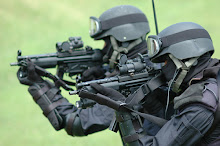
At just past midday on 17 June 2010, the guided weapons test barge Longbow was in position on the Direction Générale de l'Armement Essais de Missiles (DGA EM) range area a few miles off the Île du Levant (a small island lying off the French Riviera).
Inside, range personnel and test engineers from European missile house MBDA prepared for a critical test-firing of the UK Royal Navy's (RN's) new Sea Viper anti-air guided weapon system.
At 1255 h local time a Mirach 100/5 target vehicle launched from the Île du Levant. Back on Longbow, the back-to-back antenna of Sea Viper's Sampson multifunction radar (MFR) was rotating at 30 rpm atop a 34 m mast, its electronically scanned beams interweaving horizon search and volume search functions near instantaneously.
Twelve minutes later, the target presented and Sampson made an initial detection on a low-level target flying at high subsonic speed on a crossing trajectory. Plot confirmation and track initiation followed, with the MFR reporting the track to the Sea Viper system for threat evaluation.
Complex software-based logic, running on a high-speed processing platform, immediately prioritised the track and put the MFR into a dedicated tracking mode that increased radar dwell time on the target. The track was declared a threat, prompting weapon assignment and the relay of a launch message to Sampson.
Two Aster 30 missiles – housed inside an eight-cell SYLVER A50 vertical launcher module on Longbow 's deck – received initialisation messages, the system software providing each munition with positional information on the target and the predicted missile trajectory to intercept. The stressing nature of the threat demanded a salvo firing to maximise the probability of kill.
"Three, two, one, zero time," reported Longbow's trials manager to the range trials director. "Permit firing."
A hatch on the vertical launch silo flipped open and two seconds later an eruption of bright orange flame was followed by a trail of dirty white smoke as the first Aster 30 missile arced upwards and away from Longbow and accelerated towards its target.
( www.janes.com )
Inside, range personnel and test engineers from European missile house MBDA prepared for a critical test-firing of the UK Royal Navy's (RN's) new Sea Viper anti-air guided weapon system.
At 1255 h local time a Mirach 100/5 target vehicle launched from the Île du Levant. Back on Longbow, the back-to-back antenna of Sea Viper's Sampson multifunction radar (MFR) was rotating at 30 rpm atop a 34 m mast, its electronically scanned beams interweaving horizon search and volume search functions near instantaneously.
Twelve minutes later, the target presented and Sampson made an initial detection on a low-level target flying at high subsonic speed on a crossing trajectory. Plot confirmation and track initiation followed, with the MFR reporting the track to the Sea Viper system for threat evaluation.
Complex software-based logic, running on a high-speed processing platform, immediately prioritised the track and put the MFR into a dedicated tracking mode that increased radar dwell time on the target. The track was declared a threat, prompting weapon assignment and the relay of a launch message to Sampson.
Two Aster 30 missiles – housed inside an eight-cell SYLVER A50 vertical launcher module on Longbow 's deck – received initialisation messages, the system software providing each munition with positional information on the target and the predicted missile trajectory to intercept. The stressing nature of the threat demanded a salvo firing to maximise the probability of kill.
"Three, two, one, zero time," reported Longbow's trials manager to the range trials director. "Permit firing."
A hatch on the vertical launch silo flipped open and two seconds later an eruption of bright orange flame was followed by a trail of dirty white smoke as the first Aster 30 missile arced upwards and away from Longbow and accelerated towards its target.
( www.janes.com )

No comments:
Post a Comment